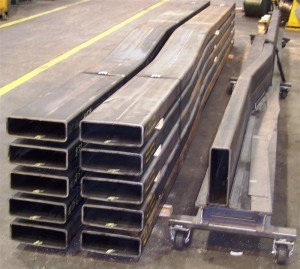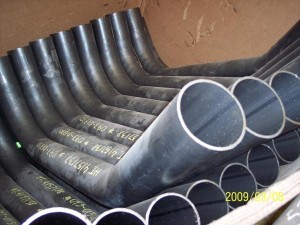Square and rectangular hollow structural sections (commonly abbreviated as HSS), are crafted the same way as pipe and tube. The manufacturing process starts with a flat steel plate that is slowly formed into a round or rectangular shape. Once the piece is formed the two edges are ready to be welded. After these pieces are welded, the hollow structural section will go through the final forming process. Once the HSS is formed into its final shape, it is cut into the desired lengths and shipped out. A portion of these HSS will end up in the hands of companies which will bend or roll them.
Prior to bending or rolling the HSS, they must make the decision on where to locate the weld seam of the steel member. The bender roller companies have the option to put the weld seam on the inside radius of the bend, the outside radius of the bend, or on the centerline radius of the bend. These decisions become more difficult on square and rectangular sections if the seam is not centered on any of the sides. Different mills produce members with welds in different places and some mills forego this step entirely by producing more expensive seamless pipe.
 Rectangular Tubes Curved with Weld Seam on Inside Top Face Rectangular Tubes Curved with Weld Seam on Inside Top Face |
 Round HSS Weld Seams on the Centerline Axis of Bend Round HSS Weld Seams on the Centerline Axis of Bend |
Typically with either a round tube or pipe, the weld seam will be located on the neutral axis, which is the centerline radius of the bend. But if requested, the seam can be put in other locations. Often with square or rectangular members the weld seam will be placed where it is most aesthetically pleasing to the customer after rolling. Although this is something that most people don’t think about when ordering curved structural steel, it is something that bending and rolling companies can adjust on request to make a piece more aesthetically pleasing.







